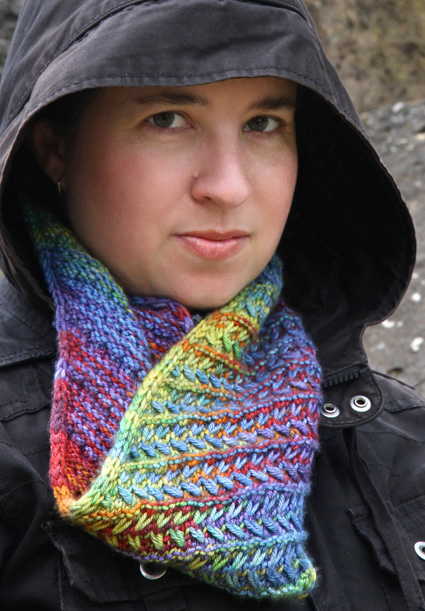

|
|
|

Everyone has at least one perfect single skein of sock yarn. Too beautiful to hide in shoes, luxurious, fun. So get your most precious skein and wear it right next to your face. Because you both deserve it.
|
||
|
|
||
|
SIZE |
|
|
FINISHED MEASUREMENTS |
|
MATERIALS Notions |
|
GAUGE |
|
PATTERN NOTES |
|
The sample cowl was knit with a single skein of yarn. Use two skeins for a long cowl you can wrap around your neck several times, or thicker yarn for a cushier cowl. A lofty, bouncy yarn will work better than a thin, drapey yarn. The pattern is knit on the bias. If you prefer, you can leave out the slanting for a straight-on pattern. To do so, leave out the M1 at the start and the K2tog at the end of each odd row. Note: Because the slipped stitches are elongated, using a cable needle doesn’t really work for the cables. As instruction, drop the stitch off the needle and hold it; return the stitch to the left needle to work it. C3L: Drop the slipped stitch off the needle and hold it in front of the work; knit next two stitches, knit the slipped stitch. This project uses a provisional cast on. Use your preferred provisional cast on technique; directions for one technique may be found here: Grafting:
Cache-cache stitch |
 |
|
DIRECTIONS Join working yarn and knit 2 rows. Work Cache-Cache pattern stitch, from chart or written instructions as you prefer. Repeat until desired length or until you run out of yarn, leaving at least 2 feet of yarn for grafting, ending after a plain knit row – pattern rows 1, 5, 11, 15, 21 or 25. The sample shown has 8 full repeats.
FINISHING |
| ABOUT THE DESIGNER |
|
Kiki Kawaii is an author, fiber artist and adventuress living in Melbourne, Australia, with her crazy cat and patient boyfriend. When she is not dyeing yarns, writing or knitting, she is probably out snowboarding, geocaching or hiking.
|
|
Pattern & images © 2015 Kiki Kawaii. Contact Kiki |